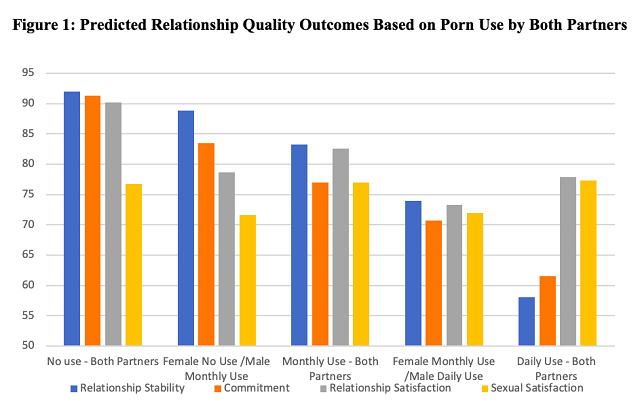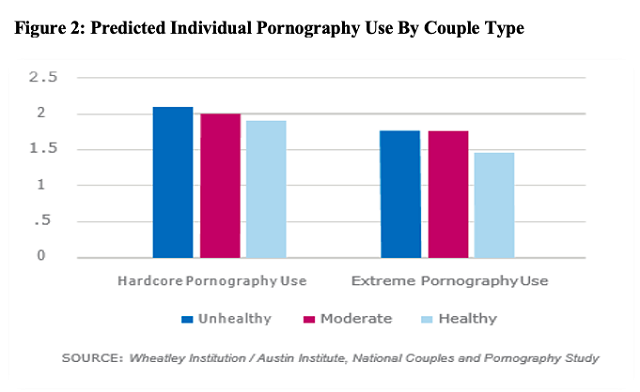Highlights
- A consistent decline in relationship stability, commitment, and relationship satisfaction occurred when the relative frequency of pornography use was higher within couples. Post This
- Individual hardcore pornography use (i.e., sexual material with full depiction of actual sex acts and nudity) was 13.6% less likely in healthy couples than in unhealthy couples. Post This
- Our findings suggest that couples who do not consume pornography have the highest levels of relationship stability, commitment, and relationship satisfaction. Post This
In a recently published article in Archives of Sexual Behavior titled “Stuck in the Porn Box,” we noted that researchers, clinicians, and policy makers may be perceiving pornography’s impact on well-being and relational health as either “always good” or “always bad.” Specifically, scholars airing on the side of “always bad” claim that negative effects of pornography use may come down to feeling guilty—feelings that may be based on religious beliefs that pornography use is morally wrong.
However, other studies that have accounted for religiosity or other underlying values have consistently found that pornography’s negative effects on well-being1 and relational health2 persisted. On the other hand, other scholars on the “always good” side maintain that negative impacts from pornography use are spurious. Essentially, because pornography’s impact on well-being and relational health is still emerging, limiting the scope of pornography’s impact into an “always good” or “always bad” box may not be the most robust approach.
Adding to our hinderance of understanding pornography’s effects simply in ‘the porn box,’ two main methodological shortcomings in pornography literature emerge: studies either do not employ the most effective measures of pornography (i.e., only measuring pornography with a vague, single item3) or do not have large, representative sample sizes—or both. To help contribute toward getting outside of the porn box and having both rigorous measures of pornography use and a representative sample size, we recently conducted a study for the Wheatley Institution and the Austin Institute that further explored pornography consumption’s impact on relationship health.
The sample for this study, which was conducted during the summer of 2020, was recruited from across the U.S. based on quotas for age, race, education level, and geographic region aimed at creating a demographically diverse sample. Participants included were at least 18 years old and in a committed relationship (i.e., seriously dating, cohabiting, or married), and the final sample consisted of 3,750 individuals. A second dataset was collected in similar fashion that included 713 romantic heterosexual couples. The results were based on both of these two samples.
In addition to assessing relationship satisfaction, stability, and commitment, the study measured pornography by specific content and frequency of use. Content was measured by softcore, hardcore, and extreme pornography. Frequency included none, daily, weekly, or monthly amounts of pornography use. Measuring content and frequency improves pornography measurement because it allows us to have a clear sense of the type of pornography content that the users are viewing—along with how often.
Couples who are in the healthiest of relationships are the least likely to consume pornography.
As seen in Figure 1, the results revealed that couples where neither partner reported using pornography had the highest levels of relationship stability, commitment, and relationship satisfaction, with 90% or above reporting that their relationship is stable, committed, and satisfying to them as a couple. Likewise, a consistent decline in relationship stability, commitment, and relationship satisfaction occurred when the relative frequency of pornography use was higher within couples.

These results line up with data from 30 national surveys that together show that pornography use is almost always a signal of poorer relationship quality. Additionally, we also conducted analyses to assess how a global measure of relationship health related to individual and joint pornography use in couples. This global measure included relationship satisfaction, relationship stability, and emotional connection. Organizing couples based on these measures resulted in three distinct groups of couples in terms of the quality of their relationship—healthy couples, moderately healthy couples, and unhealthy couples.
As shown in Figure 2 below, individual hardcore pornography use (i.e., sexual material with full depiction of actual sex acts and nudity) was 13.6% less likely in healthy couples than in unhealthy couples. And, individual extreme (i.e., sexual material that involves violence, lack of consent, and/or group sex involving more than two people) pornography use was 18% less likely in healthy couples than in unhealthy couples.

In Figure 3 below, results involving joint pornography use were similar. Those in the healthiest of relationships were 9% less likely to engage in joint hardcore pornography use than those in unhealthy relationships. Likewise, healthy couples were 15% less likely to use extreme pornography than moderate and unhealthy couples.

Through addressing two methodological limitations inherent in pornography research, utilizing a large sample size and more robust measurement, these data show a negative trend. Specifically, those who are in the healthiest of relationships are the least likely to consume pornography. While there are certainly many nuances and contextual factors to consider when examining pornography use, with stronger measurement and a national U.S. sample, it appears that those in the healthiest romantic relationships are those who also tend to avoid pornography use.
Altogether, our findings suggest that couples who do not consume pornography have the highest levels of relationship stability, commitment, and relationship satisfaction. Contrary to the porn box where pornography’s impact is assumed to be either ruin relationships or promote healthy sexuality, our results tell a different story. That is, the highest quality relationships seem to be those that avoid the consumption of pornography.
Matthew Saxey is a Family Studies Master's Student at Brigham Young University and current Wheatley Institution Student Scholar and Graduate Research Assistant. Dr. Brian Willoughby is a Professor in the School of Family Life and a fellow of the Wheatley Institution.
References
1. Perry, S. L., & Snawder, K. J. (2017). Pornography, religion, and parent–child relationship quality. Archives of Sexual Behavior, 46(6), 1747-1761. Willoughby, B. J., Carroll, J. S., Busby, D. M., & Brown, C. C. (2016). Differences in pornography use among couples: Associations with satisfaction, stability, and relationship processes. Archives of Sexual Behavior, 45(1), 145-158. Wright, P. J. (2013). US males and pornography, 1973–2010: Consumption, predictors, correlates. Journal of Sex Research, 50(1), 60-71.
2. Doran, K., & Price, J. (2014). Pornography and marriage. Journal of Family and Economic Issues, 35(4), 489-498. Maas, M. K., Vasilenko, S. A., & Willoughby, B. J. (2018). A dyadic approach to pornography use and relationship satisfaction among heterosexual couples: The role of pornography acceptance and anxious attachment. Journal of Sex Research, 55(6), 772-782. Poulsen, F. O., Busby, D. M., & Galovan, A. M. (2013). Pornography use: Who uses it and how it is associated with couple outcomes. Journal of Sex Research, 50(1), 72-83. Willoughby, B. J., Carroll, J. S., Busby, D. M., & Brown, C. C. (2016). Differences in pornography use among couples: Associations with satisfaction, stability, and relationship processes. Archives of Sexual Behavior, 45(1), 145-158.
3. Busby, D. M., Willoughby, B. J., Chiu, H. Y., & Olsen, J. A. (2020). Measuring the multidimensional construct of pornography: A long and short version of the pornography usage measure. Archives of Sexual Behavior, 49(8), 3027-3039. Willoughby, B. J., & Busby, D. M. (2016). In the eye of the beholder: Exploring variations in the perceptions of pornography. The Journal of Sex Research, 53(6), 678-688.












